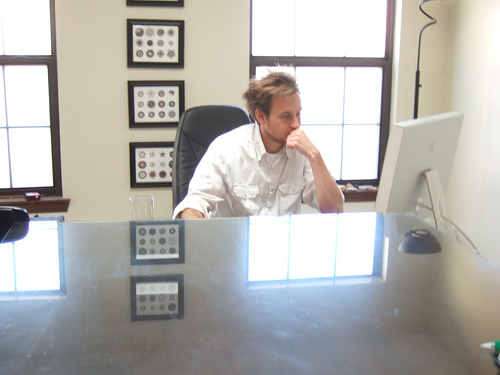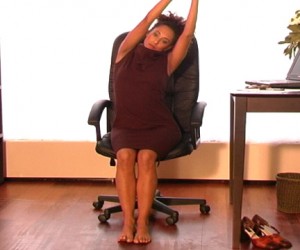by Michelle Sutton-Kerchner
The body is meant to move. Although we may not be housed in steel with a V6 engine, our bodies are still revving to go. We know the benefits of exercise. However, only recently have we begun to understand the dangers of remaining idle …
We live in an automated age. There’s a machine to do virtually every task. Heck, no movement is even required to pick up a fast food order. Talk about a double whopper. a typical day, our fingers could easily be the only thing getting activity—keyboarding, controlling the remotes, and pressing buttons to retrieve our banking and open our garages at day’s end. Tiring, but not physical.
While sitting, the body is in an idling state and muscles go silent. Studies performed on rats show this muscular shutdown was quickly followed by a dramatic drop in an enzyme that clears fat from the bloodstream. Marc Hamilton, a researcher at the Pennington Biomedical Research Center in Baton Rouge, believes artery-damaging fats are allowed to build up during every period of prolonged sitting.
Guidelines for Chair Time

New studies are constantly being launched. However, scientists are far from developing guidelines on how much sitting is dangerous and what improvement is gained by interjecting regular intervals of physical activity. Consider an 8-hour workday in front of a computer, commute time, and relaxing with a book or in front of a movie. Meeting the minimum criteria for physical activity per governmental guidelines is a start, but is it enough to offset the rest of a sedentary day?
Russell Pate, an exercise physiologist at the University of South Carolina, was part of a committee that wrote the 2009 physical activity guidelines for adults issued by the U.S. Department of Health and Human Services. These guidelines are regularly updated to incorporate new findings. Currently, they provide recommendations on exercise frequency and duration. Russell predicts future guidelines will indicate limitations on sitting as well.
Check the U.S. Department of Agriculture’s latest guidelines on physical activity at: www.mypyramid.gov/pyramid/physical_activity.html. Are you getting enough movement?
Facts to Get You Out of Your Chair
Excessive sitting is not the same as too little exercise. Even those who are slim and exercise regularly should still avoid prolonged sedentary periods. Translation: Spending two hours exercising at the Center is not a free pass for a lazy night in front of the TV.
When inclined to recline, consider these statistics:
- Every hour spent watching TV (an activity that usually involves sitting) was associated with an 18 percent increase in heart disease deaths and an 11 percent increase in deaths overall. *
- People who watched TV at least 4 hours a day were 80 percent more likely to die of heart disease than those who watched less than 2 hours a day. *
- A Canadian study of 17,000 adults also confirmed a link between chair time and deaths from heart disease. The more people sat at length, for any reason, the more likely they were to die of heart disease within 12 years. (If you knew you only had 12 years left, would you spend them sitting around?)
- The average American supposedly watches approximately 5 hours of TV daily. Do you? Track your hours in front of the screen—TV or otherwise. More numbers to know, and reduce, for your health.
*According to a study of 8,800 Australians followed for six years, as per an online report in Circulation, the Journal of the American Heart Association.
Managing Movement in the Workforce

Although you have control over non-work activities, spending time in the modern office may leave you stuck still. Sitting and sedentary tasks are commonplace as a result of emerging technologies and automation. Break it up!
An Australian study by Healy and colleagues proved the more breaks interjected in sedentary time, the lower the risk associated with waist circumference, body mass index, triglycerides, and two-hour plasma glucose. A six-centimeter difference in waist circumference was recognized between those who sat for prolonged periods and those who incorporated frequent movement throughout their days. This break can be a simple shift from sitting to standing or standing to walking.
With today’s wellness initiatives, some employers are implementing physically active work breaks. Findings indicate an increase in productivity after the break, along with an overall reduction of injury and sick time. Moving muscles every so often, even in a non-exercise fashion, is better than nothing. Another reason to head to the water cooler, in addition to rehydrating and, well yes, scooping the latest gossip.
LL Bean, a corporation in existence for almost 100 years, recognizes this benefit. They incorporate three five-minute stretch breaks daily for their sporting-goods manufacturer employees. The break is led by trained coworkers. Productivity gains offset the time designated for stretching by 100 percent. Other feedback reported by companies with such intervention programs includes a decrease in fatigue, stress, and overall physical stiffness.

Consider some chair yoga at your desk, pace a bit during conference calls, and get up and out during your lunch break. Many ignore their entitled time for a healthy lunch and eat while working. Perhaps you can’t (or choose not to) leave for the traditional lunch hour. At least make sure you do a few laps around the building to stretch your muscles. Take 15 minutes and possibly save yourself twice that in the long run.
Getting the Most from Sedentary Time
A personal trainer or Group Fitness instructor can share ideas on adding movement to your sedentary time, whether spent on an assembly line or in front of the TV. Have a set of dumbbells by your chair for a quick lift session. A kettlebell is a compact, portable tool that works the entire body. Give yourself some space and start swinging (properly, of course). Your workday may feel less stressful and your free time, more productive.
According to Fitness Manager RJ Pietrucha, “Sitting is one of the most discussed topics with Center members. Prolonged sitting can cause muscle imbalances, among other issues.” Personal trainers frequently work with clients to overcome these imbalances to avoid (or heal) injuries and reach fitness goals. A trainer can also supply a customized workout to perform when off-site. Beyond helping make the most of time on the Exercise Floor, your workout can be adapted to travel to the office or couch.
Regular exercise definitely improves your health. However, you can be an avid exerciser and still, unintentionally, increase your risk for heart disease, obesity, and other health concerns. Be cognizant of how you spend non-exercise time. Include frequent movement in your days. Fitness goes beyond what you accomplish at the Center. Make your health a lifestyle.
If you’re reading this from your iPhone while on the treadmill, kudos. Otherwise, your time for sitting is finished. Get up and get moving.
Sources
“Prolonged Sitting Boosts Bad Health,” by Kelli Miller Stacy at www.webmd.com.
“The Problem with Sitting: A Workplace Conundrum,” by Nico Pronk, American College of Sports Medicine’s Health & Fitness Journal; vol. 15, no. 1.
“Your Health: Too Much Sitting Puts the Body on Idle,” by Kim Painter at www.usatoday.com.
Image Credits
Traffic jam: www.flickr.com/photos/yoshimov/12630121/
Computer sitting: www.flickr.com/photos/generated/1952501972
Desk Yoga: www.flickr.com/photos/myyogaonline/457339544
 Fitness & Wellness News Your Source for Fitness News, Wellness News, Health News, and Nutrition News!
Fitness & Wellness News Your Source for Fitness News, Wellness News, Health News, and Nutrition News!



